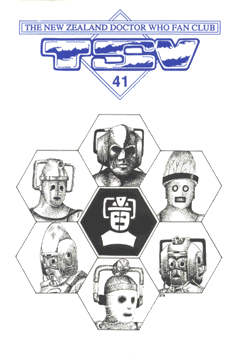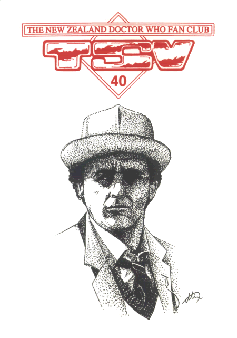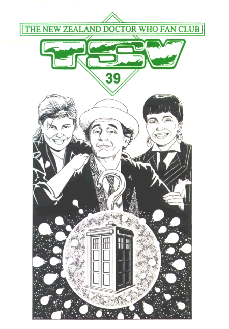
Published in October 1994, TSV 41 marked the thirtieth anniversary of Doctor Who's first broadcast on New Zealand television (the exact date was 18 September 1964). A set of three articles by myself, Graham Howard and Nigel Windsor examined aspects of this theme. These items have been left out of the online edition. It might seem a little odd to overlook what were effectively the lead articles, but I have my reasons. Nigel's piece speculated on which TV channel might play the series next (it was off air at the time) which is of course now very dated, Graham's article was a research piece about the NZBC archives, since superceded by Jon Preddle's research in recent issues, and my own overview of the history of Doctor Who on New Zealand TV is much better represented by the Another Time and Space e-book. However these omissions don't particularly harm the online edition as there's still a good solid chunk of material from TSV 41 to revisit.
The highlight of the issue is to my mind Phillip J Gray's defence of a much-maligned story in Why the Nimon Should be Our Friends. That article was selected as the sole example of TSV's output in Paul Cornell's Licence Denied fanzine anthology. It's a great article which I think is at least partly responsible for some fans reassessing The Horns of Nimon and also re-evaluating the relative merits of the Graham Williams and John Nathan-Turner eras. Although Phillip was a regular reader he hadn't written very much for TSV up to this point, but TSV 41 saw a sudden surge of contributions from this talented writer. It's likely that the Continuum '94 convention a few months earlier - at which we'd met for a first time and got on very well - was the catalyst for this surge of inspiration and enthusiasm.
Another provider of much of the issue's content was the ever-reliable Jon Preddle, contributing several pieces including a script to screen instalment for Vengeance on Varos, an item about Gallifreyan language complete with Jon's sketches of various on-screen examples of Time Lord script, and also a fairly detailed history of K9. Jon was a god-send when content for TSV was in short supply. I could phone him up and ask for an article on a particular subject and without fail a floppy disk would drop through the mailbox (these were the days before the Internet, of course) with exactly what I'd asked for.
While I was scanning each of the pages for this online edition, I noticed in the 'New Series Rumours' news page a report that Paul McGann had been offered the role of the Doctor but had turned it down. What makes this remarkable was that the TV movie was still a year away from being made, and that at that time McGann would of course finally accept the part.
Tim Hill's cover artwork - featuring many different Cyberman heads (including the proposed Dark Dimension version) - doesn't relate at all to the issue's content, as there's nothing in particular about the Cybermen within. It's no reflection at all on Tim's great drawing, but the issue should perhaps have had a Horns of Nimon themed cover. Coincidentally this was the last of Tim Hill's front cover artwork.
Click here to read TSV 41.







